|
|
|
Clark County Press, Neillsville, WI April 24, 1996, Page 32 Transcribed by Dolores (Mohr) Kenyon. Index of "Oldies" Articles |
|
|
|
Clark County Press, Neillsville, WI April 24, 1996, Page 32 Transcribed by Dolores (Mohr) Kenyon. Index of "Oldies" Articles |
Good Old Days
“Oldies”
Town of Lynn
By Dee Zimmerman
Organized on Mar. 21, 1862, the Township of Lynn’s area consisted of what are now Fremont, Lynn and Grant. The meeting took place at the home of John Wage. Homesteading land became available in the 1850’s with few settlers coming to the area until the 1860’s. Grant separated to become its own township in 1868. In 1874 Fremont originated its township.
Early land records weren’t necessarily accurate with purchase dates as it was not until July 5, 1864 that land titles were regularly recorded by the Register of Deeds. That area was surveyed much later. Hiran Renne was one of the early surveyors, probably due to the fact that he owned a large amount of land in the area as one of its first settlers. John Kintzele did detailed surveying (sections and forty lines) in the Town of York after his arrival in 1883.
The Clark County administration was made up of a three man board of commissioners and various officers in the county’s early years. Charles Renne was the representative from Weston. Harlan Allen was selected in 1869-70. In 1870 the County Board system was started.
Founders of the Town of Lynn in 1856 were George Ure and Gottlieb Sternitzky. Samuel F. Weston, as records indicate, was the first to enter land in the Town of Lynn as early as Oct. 1854, sections 17, 18, 19, 20 and 30. George Kleinschmidt filed on land in section 1.
Alonzo Brooks was town chairman in 1870. At that time, he also served on the County Board, one of eight members. Each organized township had one representative. The Town of Lynn was assessed one and a half per cent of the $2,594 school tax, and amount of $195.00.
Logging was the main occupation of the early settlers, to be followed by farming once the land was cleared. Other early settlers were Yankees, Williams, Wage, Brooks, Marshes, Nelsons and Levis.
The Lynn Mutual Fire Insurance Co. was organized in 1878, Thomas Reed being the first president and Charles Sternitzky the first secretary.
The Lynn Mutual Tornado, Cyclone or Hurricane Insurance Company was organized by the directors of the Lynn Mutual Fire Insurance Co. on Mar. 2, 1905 and started business on June 1 of that year. The company’s first claim was on damage to property of seven policy holders when a big storm hit near Withee on June 3rd, with losses of $484.50. The company was in existence for many years before dissolving.
Early maps of the Town of Lynn indicate a warehouse, feed mill, a dept, saloon and a blacksmith shop. In addition a grocery store, heading and shingle mill, feed mill, post office, general store, hotel, post office machinery shop, hardware store, drug store, shoe repair and sales, repair shop, milliner, garage, doctor’s office and town hall.
The Lynn area had some of the first cheese factories to be established in Clark County. An 1885 Neillsville Times ran a news item in the Oct. 20 issue: “Charles Sternitzky came in last Thursday with 3,000 pounds of cheese for shipment to Minneapolis. It was some of the product of the Lynn factory, and of excellent quality.” Otto Becker owned and operated the cheese and butter factory, circa 1900. At the time, he was receiving 8,000 pounds of milk daily from 60 patrons and at the peak of the season he accepted 10,000 pounds of milk. The 1909 auditors recorded two creameries, Lynn-Enterprise Creamery and also the Star Cheese Factory (2 miles south of Lynn). A cheese factory at the Lynn site still is in existence today. The Lynn Dairy label is a familiar brand with varieties of cheese available through out the state, a pioneer in the business.
First town officers were Alonzo Brooks as chairman and Chas. Sternitzky as clerk, in 1883. The first recorded town levy was the amount of $900 in April 1884. The population of Lynn Village was 525 in 1890.
One of Lynn’s businesses was the Heading Mill. The following paragraphs will relay information about that mill and town through the memories of Henry Helm as he told them to his daughter.
The Mill was built and started by Ernest Sternitzky (Henry’s grandfather) Sec. – Treas.: Henry Sternitzky, Ernest’s brother: Firemen, Ed Sternitzky, Ernest’s son-in-law and Sawyer, Fred Hadky. Ferd Helm, Henry’s dad, sharpened and cared for the saws, as well as sizing the logs.
The Mill was located near the present Lynn Dairy factory. Dr. Schultz was the medical doctor; James Sternitzky, shoemaker; feed elevator, run by Ed Sternitzky and a Capelle, Fred Sternitzky had the shingle mill, and Brook’s owned the farm charcoal kiln.
The Lynn Heading Mill was in full operation during the early 1900’s, providing income to nearby farmers. Virgin timber was cut from the farmers’ land and sawed into 30” x 32” bolts (lengths) to sell to the Mill. It was purchased by the cord. The logs were Popple, basswood, or pine. The Mill operated from February and worked until “seedin’ time” handling over 600 cords per season. The “heading mill” made heads for wooden pails in which food items such as candy, herring, etc. were packed for shipping and sale. The tops and bottoms of the pails were the “head” or “headings”. The staves made up the sides of the pails and were sawed at that mill, also.
After the bolts reached the Mill, the bark was removed by a “joiner” and burned in the steam engine to heat the boiler which produced steam to power the saws. Some slabs were burned and left-overs were taken by the farmers to be used for home firewood.
Bolts were sawed into 3” x 15” staves, hauled on a plank road-way from Mill to storage stacks. Specially built 6 ft. wheel- barrows were stacked in unbelievable heights of staves. Kids were hired for 25 cents a day to load the wheelbarrows. The circular storage pile had a 6” empty center, as staves were laid side-by-side in a circle with four or five more circles around the first circle. The completed pile was twenty feet across and ten feet high.
Staves were allowed to dry in those stacks until July after which they were loaded into rail box cars to be shipped to the wooden-ware Factory in Menasha, Wis. The railroad was a spur from Dexterville and ran as far as the Benny Garbisch farm in Romadka with a “Y” at the David Anderson farm, and a turn-table at Lynn near the stock yards on the north side of the highway. The Depot was on the south side of Lynn with the train going through twice a week.
In the heat of July, farmers helped load the box cars, enduring the imaginable heat with-in the box cars. The company furnished cold beer for the workers on the hot days. Kids were paid to carry the 8 quart buckets of beer, served with a dipper, from the local tavern to the workers. The buckets of beer cost 25 cents each.
Another job for the kids was pumping water by hand from the creek to be used for the steam engine boiler. It wasn’t unusual to pump for hours to get enough needed water.
The mill workers carried lunch from home when they worked at the mill. On occasion, they netted fish from the creek with a trap and prepared their catch by frying it over a bon fire on the creek’s bank.
Two mill workers, Fred Lemke and Charlie Helm were “sweet” on the same young maiden, Emma Nitchke, and not hiding their feelings – got into some heated discussions over her. However, Charlie became the winner of Emma’s affections, as the two were married.
The mill eventually became obsolete, running out of orders due to advancing times and the mill was demolished in later years.
As in all communities during that time, there was a dance pavilion. Lynn’s Pavilion was located north of the highway and beyond the stockyards. It was the center of recreation and public gatherings. Many of that generation remembered one particular night when the hall was bulging and bouncing with dancers as it rained and rained outdoors. When the regular quitting time came and as the dancers left for home, they discovered the creek had rose and washed out the bridge. So, what to do? They returned to the hall and danced the night away – as the sun came up, they trekked their way home, taking the long way through a neighbors pasture. What did the parents say as their young –people came home late? Probably reminded them that chores had to be done or a day’s work was expected of them before they were to get any sleep. They worked hard and played hard in those times.
(Our thanks to Elaine Seefeldt for sharing her father’s memories)
¤¤¤¤¤¤¤¤
We are never present with, but always beyond ourselves; fear, desire, hope, still push us on towards the future.
--Montaigne
¤¤¤¤¤¤¤¤¤¤¤
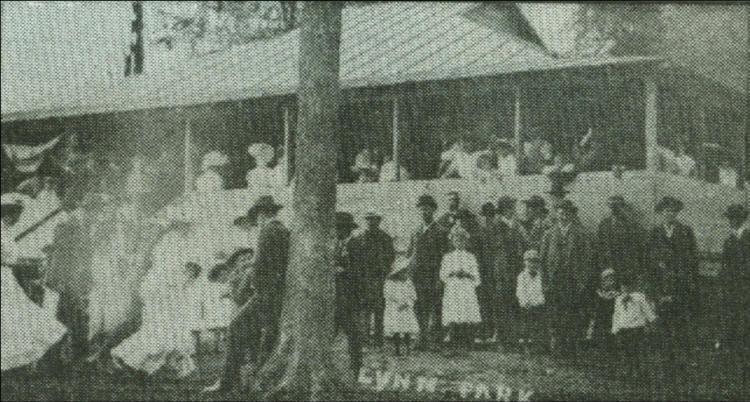 |
A July 4th celebration in early 1900’s was held at the Lynn Park
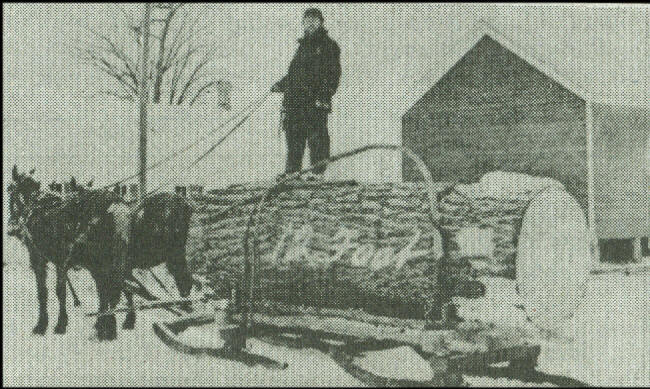 |
Albert Sternitzky harvested a large tree, hauling one section at a time on a sled.
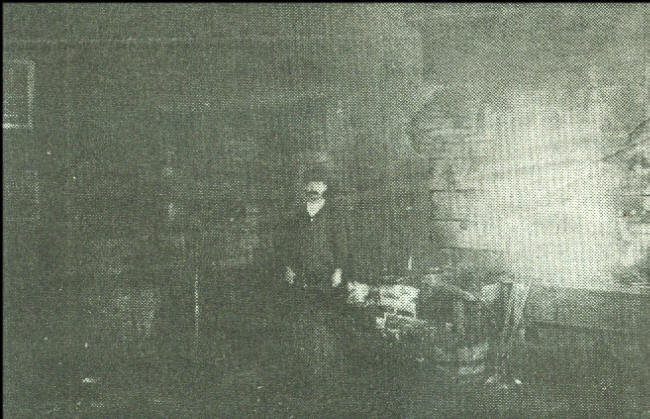 |
The Lynn Blacksmith Shop was in a log building which later was the Lynn Feed Mill location.
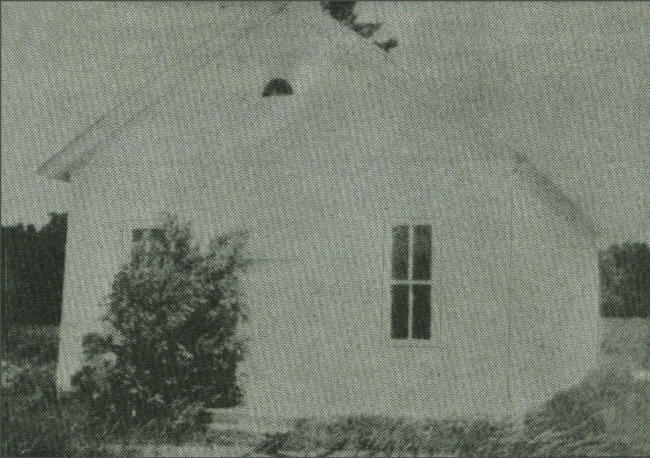 |
Lynn Town Hall was built in 1880’s
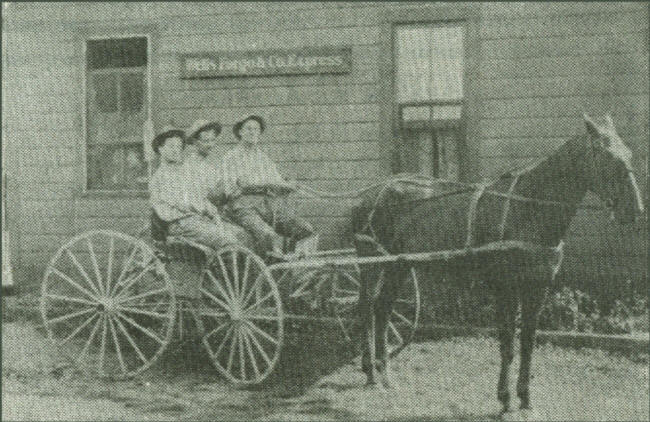 |
Lynn Depot, circa 1900, Harry Cole, Albert Riedel and Otto Hanze
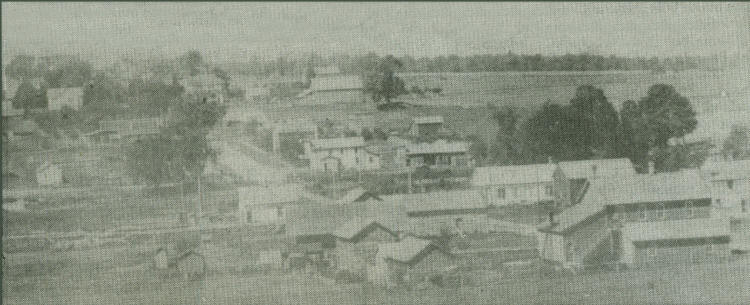 |
A view of Lynn in 1909, the road running through the town is now Highway 10.
(Photo courtesy of Jerry Quicker)
|
© Every submission is protected by the Digital Millennium Copyright Act of 1998.
Show your appreciation of this freely provided information by not copying it to any other site without our permission.
Become a Clark County History Buff
|
|
A site created and
maintained by the Clark County History Buffs
Webmasters: Leon Konieczny, Tanya Paschke, Janet & Stan Schwarze, James W. Sternitzky,
|